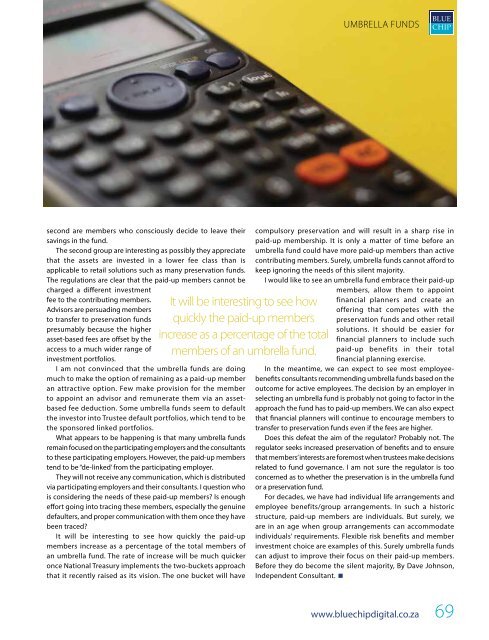Blue Chip Issue 81
Blue Chip is a quarterly journal for the financial planning industry and is the official publication of the Financial Planning Institute of Southern Africa NPC (FPI), effective from the January 2020 edition. Blue Chip publishes contributions from FPI and other leading industry figures, covering all aspects of the financial planning industry. Blue Chip takes this opportunity to wish the FPI a happy 40th anniversary. Congratulations!
Blue Chip is a quarterly journal for the financial planning industry and is the official publication of the Financial Planning Institute of Southern Africa NPC (FPI), effective from the January 2020 edition. Blue Chip publishes contributions from FPI and other leading industry figures, covering all aspects of the financial planning industry.
Blue Chip takes this opportunity to wish the FPI a happy 40th anniversary.
Congratulations!
Create successful ePaper yourself
Turn your PDF publications into a flip-book with our unique Google optimized e-Paper software.
UMBRELLA FUNDS<br />
second are members who consciously decide to leave their<br />
savings in the fund.<br />
The second group are interesting as possibly they appreciate<br />
that the assets are invested in a lower fee class than is<br />
applicable to retail solutions such as many preservation funds.<br />
The regulations are clear that the paid-up members cannot be<br />
charged a different investment<br />
It will be interesting to see how<br />
quickly the paid-up members<br />
increase as a percentage of the total<br />
members of an umbrella fund.<br />
fee to the contributing members.<br />
Advisors are persuading members<br />
to transfer to preservation funds<br />
presumably because the higher<br />
asset-based fees are offset by the<br />
access to a much wider range of<br />
investment portfolios.<br />
I am not convinced that the umbrella funds are doing<br />
much to make the option of remaining as a paid-up member<br />
an attractive option. Few make provision for the member<br />
to appoint an advisor and remunerate them via an assetbased<br />
fee deduction. Some umbrella funds seem to default<br />
the investor into Trustee default portfolios, which tend to be<br />
the sponsored linked portfolios.<br />
What appears to be happening is that many umbrella funds<br />
remain focused on the participating employers and the consultants<br />
to these participating employers. However, the paid-up members<br />
tend to be “de-linked’ from the participating employer.<br />
They will not receive any communication, which is distributed<br />
via participating employers and their consultants. I question who<br />
is considering the needs of these paid-up members? Is enough<br />
effort going into tracing these members, especially the genuine<br />
defaulters, and proper communication with them once they have<br />
been traced?<br />
It will be interesting to see how quickly the paid-up<br />
members increase as a percentage of the total members of<br />
an umbrella fund. The rate of increase will be much quicker<br />
once National Treasury implements the two-buckets approach<br />
that it recently raised as its vision. The one bucket will have<br />
compulsory preservation and will result in a sharp rise in<br />
paid-up membership. It is only a matter of time before an<br />
umbrella fund could have more paid-up members than active<br />
contributing members. Surely, umbrella funds cannot afford to<br />
keep ignoring the needs of this silent majority.<br />
I would like to see an umbrella fund embrace their paid-up<br />
members, allow them to appoint<br />
financial planners and create an<br />
offering that competes with the<br />
preservation funds and other retail<br />
solutions. It should be easier for<br />
financial planners to include such<br />
paid-up benefits in their total<br />
financial planning exercise.<br />
In the meantime, we can expect to see most employeebenefits<br />
consultants recommending umbrella funds based on the<br />
outcome for active employees. The decision by an employer in<br />
selecting an umbrella fund is probably not going to factor in the<br />
approach the fund has to paid-up members. We can also expect<br />
that financial planners will continue to encourage members to<br />
transfer to preservation funds even if the fees are higher.<br />
Does this defeat the aim of the regulator? Probably not. The<br />
regulator seeks increased preservation of benefits and to ensure<br />
that members’ interests are foremost when trustees make decisions<br />
related to fund governance. I am not sure the regulator is too<br />
concerned as to whether the preservation is in the umbrella fund<br />
or a preservation fund.<br />
For decades, we have had individual life arrangements and<br />
employee benefits/group arrangements. In such a historic<br />
structure, paid-up members are individuals. But surely, we<br />
are in an age when group arrangements can accommodate<br />
individuals’ requirements. Flexible risk benefits and member<br />
investment choice are examples of this. Surely umbrella funds<br />
can adjust to improve their focus on their paid-up members.<br />
Before they do become the silent majority, By Dave Johnson,<br />
Independent Consultant. <br />
www.bluechipdigital.co.za<br />
69


















